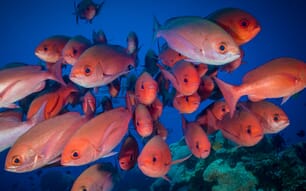More than 500 vessels are endorsed to trawl in NSW waters, harvesting up to 4500 t of seafood valued at > $36 million per year.
Like virtually all fishing methods, the trawls used in NSW not only catch the targeted species and their sizes, but also unwanted organisms (collectively termed ‘bycatch’) that are then discarded at sea. During the past 20 years, concerns over the mortality of bycatch discarded by NSW trawlers have resulted in numerous studies aimed at developing subtle changes to gears to improve their selectivity.
Much of this work has focused on small trawlers targeting school prawns in estuaries. Depending on the particular bycatches of concern, a range of different modifications to trawls have been developed. These include bycatch reduction devices (BRDs) designed to exclude mostly unwanted fish based on either their size or behaviour, and more recently, square-mesh (made from 27- to 29-mm mesh hung on the bar) instead of diamond-mesh (40 - 45 mm) codends to reduce the numbers of school prawns considered too small for sale.
For the most part, all modifications to trawls have been extensively tested on a fishery-specific basis according to the species of concern (which varies among estuaries).
However, one small component of the NSW estuarine trawl fishery that has received comparatively less attention involves trawling for squid in the Hawkesbury River. This fishery comprises up to 20 vessels that annually harvest more that 20 t of mostly broad and Luminous Bay squid, but also several species of legally retained fish (termed ‘byproduct’).
As part of recent changes to trawling regulations in estuaries, a range of BRDs and square-mesh codends were introduced into this fishery. But unlike for school prawn trawlers, very little information was available on the effectiveness of modifications to squid trawls, and especially square-mesh codends.
This study aimed to address the above shortfall by comparing the performance of a conventional codend made from 41-mm diamond-shaped mesh and two new designs made from 29- and 32-mm mesh hung on the bar (i.e., square-shaped mesh). All codends had a Hawkesbury panel BRD (originally designed to exclude mulloway) installed and were tested with a fine-meshed cover that retained all of the escaping organisms.
Compared to the 41-diamond codend, both square-mesh codends incrementally and significantly reduced the catches of small legally retained whitebait, but had no effect on bycatches. The 32-square codend also significantly reduced the catches of byproduct and the targeted squid. The large sizes of fish comprising bycatch meant that few escaped through the Hawkesbury River panel BRD (only two mulloway were caught during the entire study) from any of the codends.
The results support the utility of square mesh for consistently improving and maintaining openings in codends, but the current management of the Hawkesbury River squid fishery means that such configurations would result in some economic loss and, for the 29- and 32-mm codends tested here, no concomitant reduction in bycatch.
This study reiterates the need for bycatch issues to be clearly identified on a fishery- and species-specific basis, and prior to the implementation of physical modifications to trawls.
Diamond vs. Square-Mesh Codend Selectivity
Researchers from the New South Wales (NSW), Australian Department of Industry and Investment look at the methods available for harvesting estuarien squid trawls.

